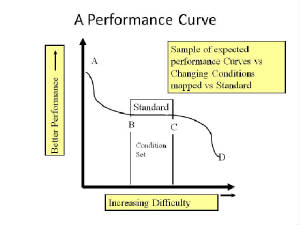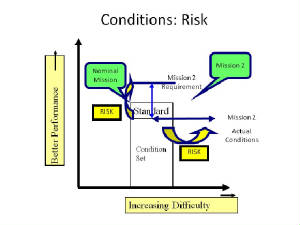|
|
3. Appreciate Conditions. Consider, comprehend, and appreciate the effects Conditions have on performance. Changing Conditions also alter risk.Standards cannot be set in a vacuum. Page A-3 of the UJTL notes: “standards, when linked to conditions, provide a basis for planning, conducting, and evaluating military operations as well as training events.” Conditions matter: both in terms of how we prepare and train for mission success, and in terms of how we approach the expected environment we actually will face. METL conditions are chosen by “relevance”- either the selected condition bounds the range of the expected operational environment, or the condition affects achievement of the stated performance standard. To understand the effects of conditions, consider the following example. A ship must be able to recover a man overboard, even in extreme conditions of winds, seas and darkness. In that case, recovering the man without sustaining any other losses might be a good standard. However, in designing a training performance standard, the standard of recovering the simulated man overboard in less than 10 minutes is predicated on a more benign condition set. Now let’s evaluate two ships in a training environment: The first has a clear day with almost perfect seas and very light winds. It maneuvers to recover the “man” in 9 1/2 minutes. The second runs its drill near dusk, with 5-7 foot seas and NW winds at 15-18 knots. It also meets the less than 10-minute standard, barely at 9:58. Which ship is more ready? Under the old system, both look equal. Each met the standard; however, the second ship met the standard in a more challenging environment. Should it get greater credit for its achievement in a higher level of difficulty? Readiness expectations should consider the effect not only of the conditions under which a unit gains task execution experience, but also be able to predict expected performance levels as the condition set changes. Under the old paradigm of readiness reporting, we said we were “ready” if we had all the resources aligned for success -“SORTS” is input-measures based.[16] Under the MET-based readiness approach, we describe our readiness to meet performance standards. We still employ resources, but also have developed ways to link these resource requirements with performance expectations to provide the confidence that we can meet the standard. Conditions help us understand the level of difficulty for task performance.
METL language expresses conditions in three themes: physical, military, and civil. Other mission analysis practices use terms like “METT-TC” (mission, enemy, terrain and weather, troops and support available, time available, and civil considerations), or PMESII (Political, Military, Economic, Social, Infrastructure, and Information). The UJTL/ UNTL Conditions Library enables any of these views to be expressed in MET “Task, Conditions, Standards” statements. Appreciating NMETL conditions also helps commanders quantify “risk.” Through our training and mission rehearsal efforts, the commander gains confidence in NMET performance in anticipated conditions (as specified in the NMET). Commanders must determine the effects a new environment will have on future performance and evaluate the new "risk" based on an analysis of future performance against the updated condition sets. Commanders also use “conditions” to describe pre-states, mid-states or end-states of the mission. “Effects” and conditions occupy the same “system state” or “space”- the operating environment. In an “Effects-based” thinking approach, effects are changes in the system state or conditions. Effects result from actions such as task performance or environmental changes. Conditions and effects also can be grouped by “who has control.” In some instances, I can set the desired conditions; at other times, the adversary sets the conditions; and often, neither of us has control of some conditions (e.g. weather). Likewise, in observing “effects”, I can choose my response to observed effects; the enemy can choose the way he responds to (and orients to observe) the effects from his perspective, and other times, no one can control how third-party participants in the condition space may respond to the change. Further, I may choose to design “effects” -a change in state (the conditions)- to convince an adversary to choose a specific COA. However, that adversary may recognize other options besides the COA I desired him to choose. He always has the option to refuse – see Eddie Izzard ‘s “Cake or Death” skit for further explanations. Go to Step 4 Grasp "Universal"
|
Enter supporting content here

